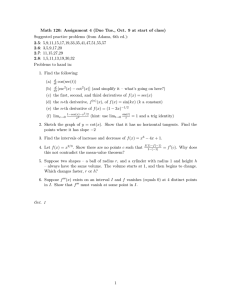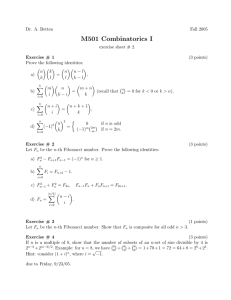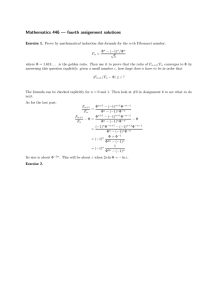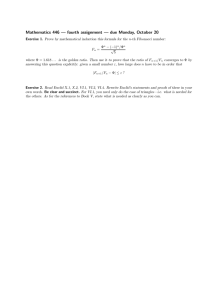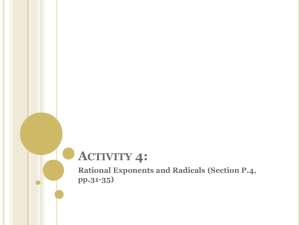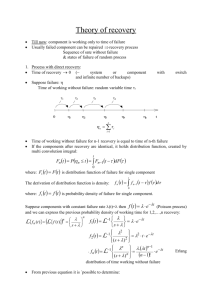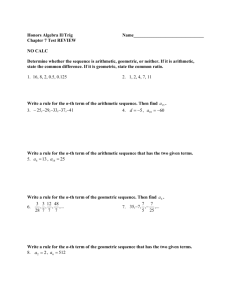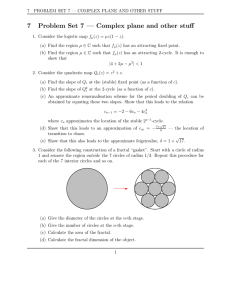Sequences handout
advertisement
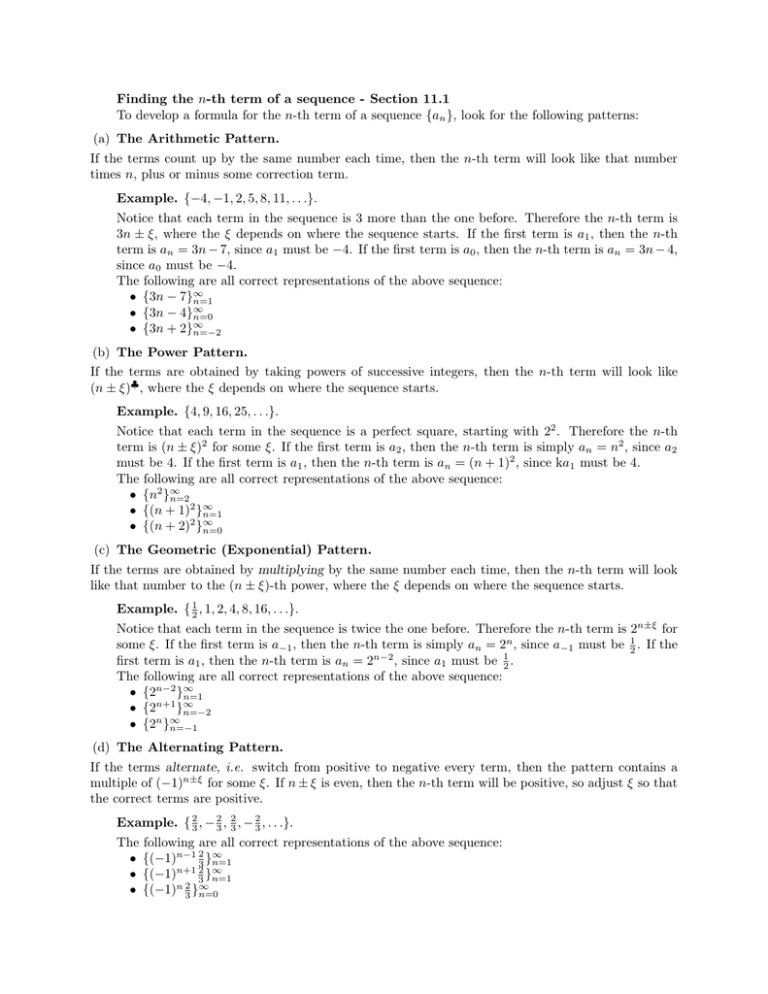
Finding the n-th term of a sequence - Section 11.1
To develop a formula for the n-th term of a sequence {an }, look for the following patterns:
(a) The Arithmetic Pattern.
If the terms count up by the same number each time, then the n-th term will look like that number
times n, plus or minus some correction term.
Example. {−4, −1, 2, 5, 8, 11, . . .}.
Notice that each term in the sequence is 3 more than the one before. Therefore the n-th term is
3n ± ξ, where the ξ depends on where the sequence starts. If the first term is a1 , then the n-th
term is an = 3n − 7, since a1 must be −4. If the first term is a0 , then the n-th term is an = 3n − 4,
since a0 must be −4.
The following are all correct representations of the above sequence:
• {3n − 7}∞
n=1
• {3n − 4}∞
n=0
• {3n + 2}∞
n=−2
(b) The Power Pattern.
If the terms are obtained by taking powers of successive integers, then the n-th term will look like
(n ± ξ)♣ , where the ξ depends on where the sequence starts.
Example. {4, 9, 16, 25, . . .}.
Notice that each term in the sequence is a perfect square, starting with 22 . Therefore the n-th
term is (n ± ξ)2 for some ξ. If the first term is a2 , then the n-th term is simply an = n2 , since a2
must be 4. If the first term is a1 , then the n-th term is an = (n + 1)2 , since ka1 must be 4.
The following are all correct representations of the above sequence:
• {n2 }∞
n=2
• {(n + 1)2 }∞
n=1
• {(n + 2)2 }∞
n=0
(c) The Geometric (Exponential) Pattern.
If the terms are obtained by multiplying by the same number each time, then the n-th term will look
like that number to the (n ± ξ)-th power, where the ξ depends on where the sequence starts.
Example. { 21 , 1, 2, 4, 8, 16, . . .}.
Notice that each term in the sequence is twice the one before. Therefore the n-th term is 2n±ξ for
some ξ. If the first term is a−1 , then the n-th term is simply an = 2n , since a−1 must be 21 . If the
first term is a1 , then the n-th term is an = 2n−2 , since a1 must be 21 .
The following are all correct representations of the above sequence:
• {2n−2 }∞
n=1
• {2n+1 }∞
n=−2
• {2n }∞
n=−1
(d) The Alternating Pattern.
If the terms alternate, i.e. switch from positive to negative every term, then the pattern contains a
multiple of (−1)n±ξ for some ξ. If n ± ξ is even, then the n-th term will be positive, so adjust ξ so that
the correct terms are positive.
Example. { 32 , − 23 , 23 , − 23 , . . .}.
The following are all correct representations of the above sequence:
• {(−1)n−1 23 }∞
n=1
• {(−1)n+1 23 }∞
n=1
• {(−1)n 23 }∞
n=0
(e) A Combination of Patterns.
Combine the above techniques, but be careful to adjust everything so that the patterns all start correctly.
6
8
Example. {0, 23 , − 49 , 27
, − 81
, . . .}.
Observe the following patterns:
(i) Counting by 2’s in the numerators
(ii) Powers of 3 in the denominators
(iii) Alternating terms, starting with a negative
Therefore our n-th term will look something like
(−1)♣
2n ± ♥
.
3♠
Choose an n to begin with. I’ll pick n = 0. Then adjust everything so that plugging in n = 0 gives
a0 = 0:
2n
an = (−1)n+1 n .
3
Alternate solution: start with n = 1. Then the sequence is
∞
2n − 2
(−1)n n−1
3
n=1
Notice the following convenient trick:
Convenient Trick. To start the sequence from n = 1 instead of n = 0, I replaced all the n’s in the
n-th term formula by n − 1. Similarly, if I had wanted to begin with n = −43, I could have replaced
all the n’s in the n-th term formula by n + 43:
∞
n+44 2n + 86
(−1)
3n+43 n=−43
Practice Problems.
For each problem, find a formula for an . If your first term is not a1 , be sure to make it clear what
your first term is by writing the sequence in the form {an }∞
n=? .
1. {1 · 4, 4 · 8, 7 · 16, 10 · 32, . . .}
2. {−8, −1, 0, 1, 8, 27, 64, . . .}
256
3. {− 61 , 47 , −2, 64
9 , − 10 , . . .}
